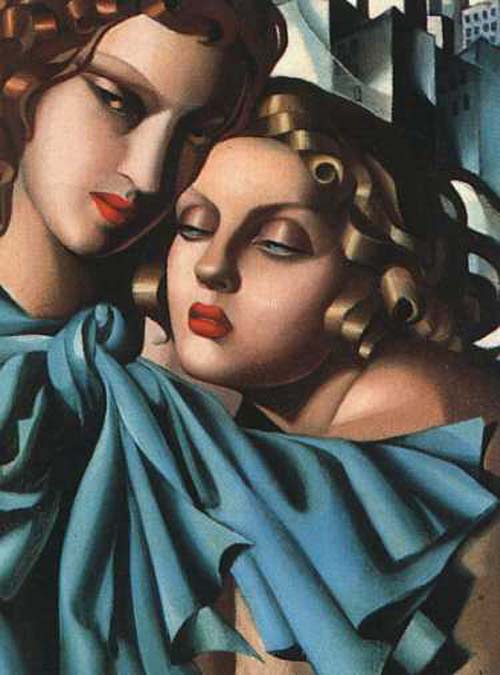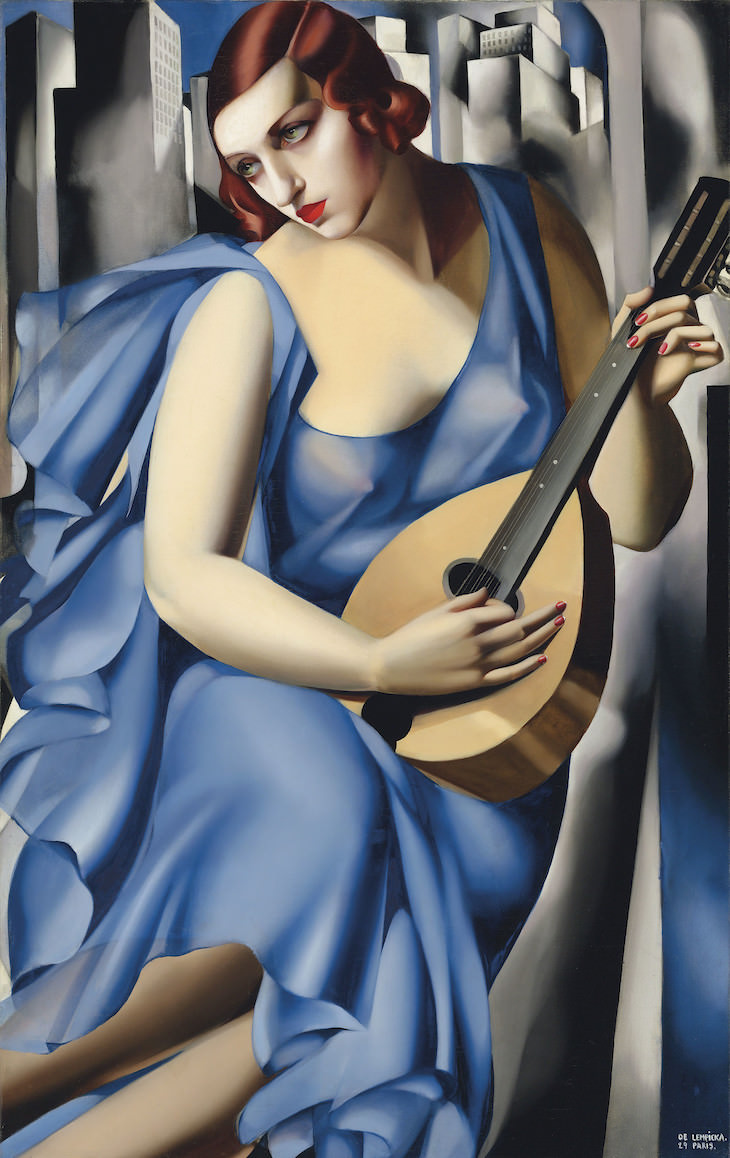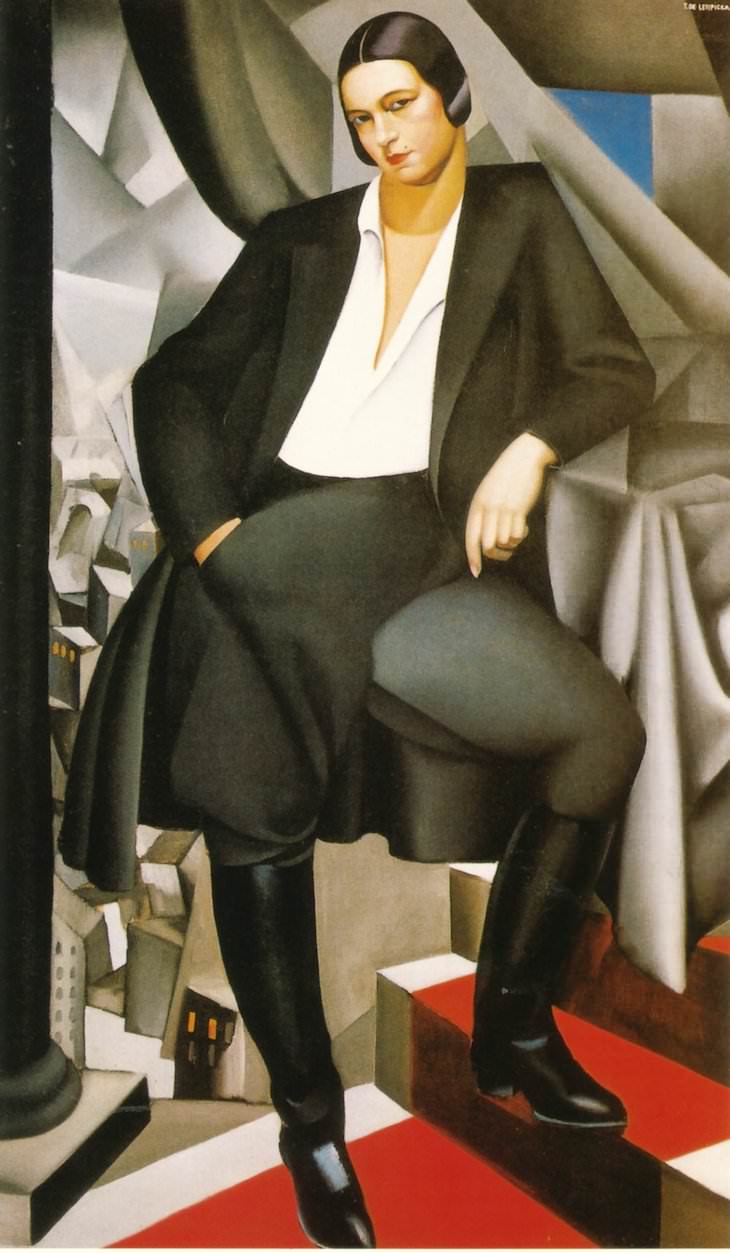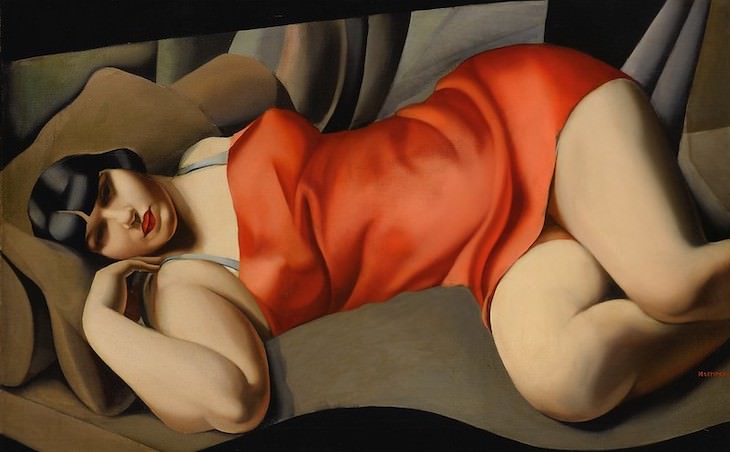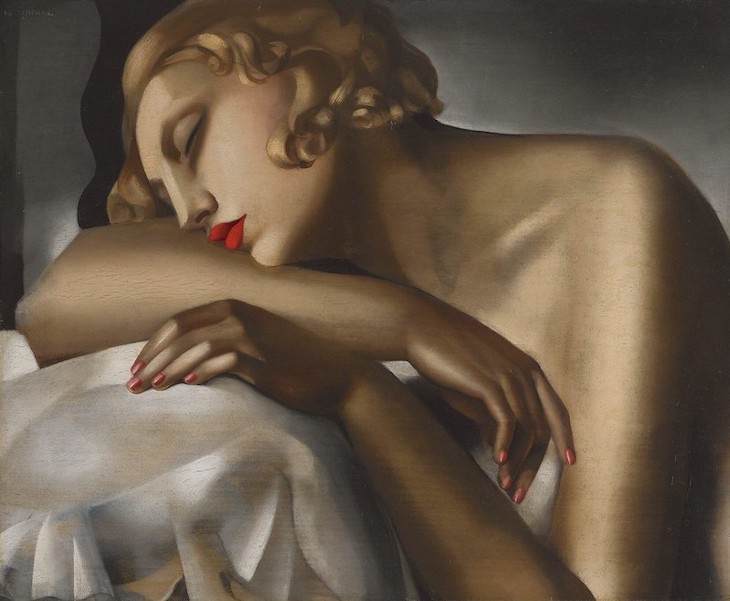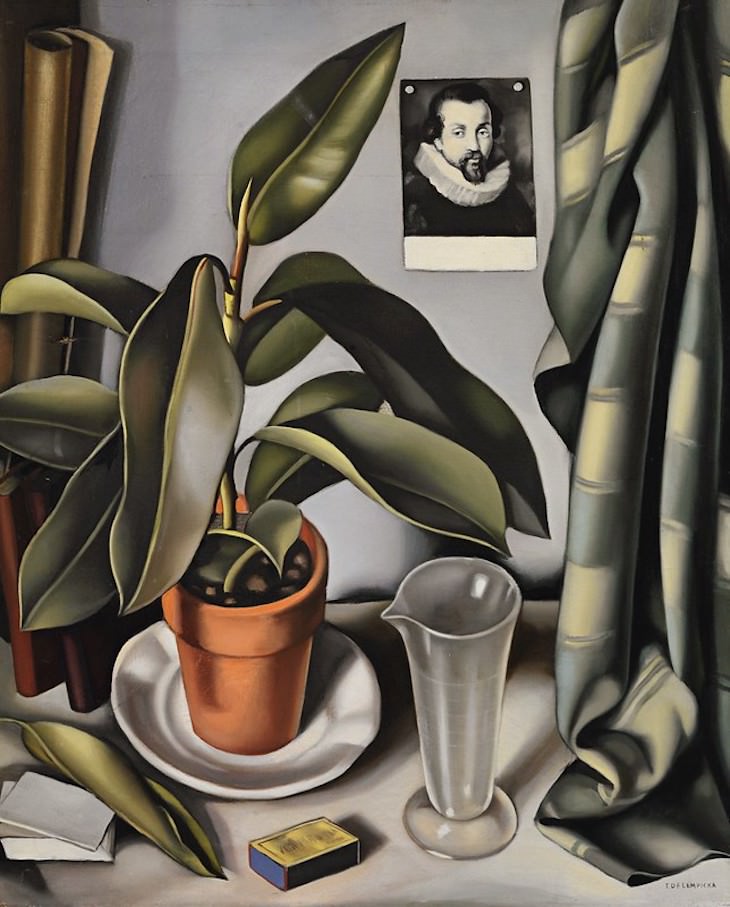
Beyond being a groundbreaking artist and iconoclast, Tamara de Lempicka is also a symbol of women’s liberation who defied the social conventions of her time in order to pursue her passions and contribute to society.
She was born under the name Tamara Rozalia Gurwick-Gorska in Warsaw in 1898. De Lempicka's family was wealthy, and at the age of 13, she was sent to a boarding school in Lausanne, Switzerland. However, she quickly dropped out in favor of touring Italy with her grandmother. That trip helped fuel her interest in art. After her parents' divorce, she moved to Saint Petersburg where she fell in love with and wed Tadeusz Lempicki, a prominent lawyer. The Russian Revolution caused the couple to flee to Copenhagen, then London, and finally to Paris.
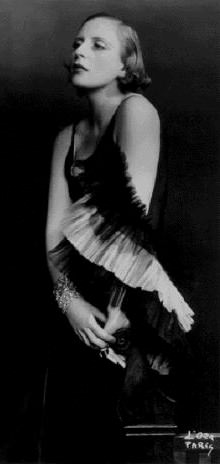
In 1925 de Lempicka exhibited her work at two major venues - the Salon des Tuileries and the Salon des Femmes Peintres. This event was an important breakthrough for the artist, as her paintings were seen by numerous journalists from international fashion magazines and her work began to gain popularity.
Related: 34 Paintings Made By Picasso From Different Eras of Art


Kizette in Pink, 1926, oil on canvas, Image Source: Flickr
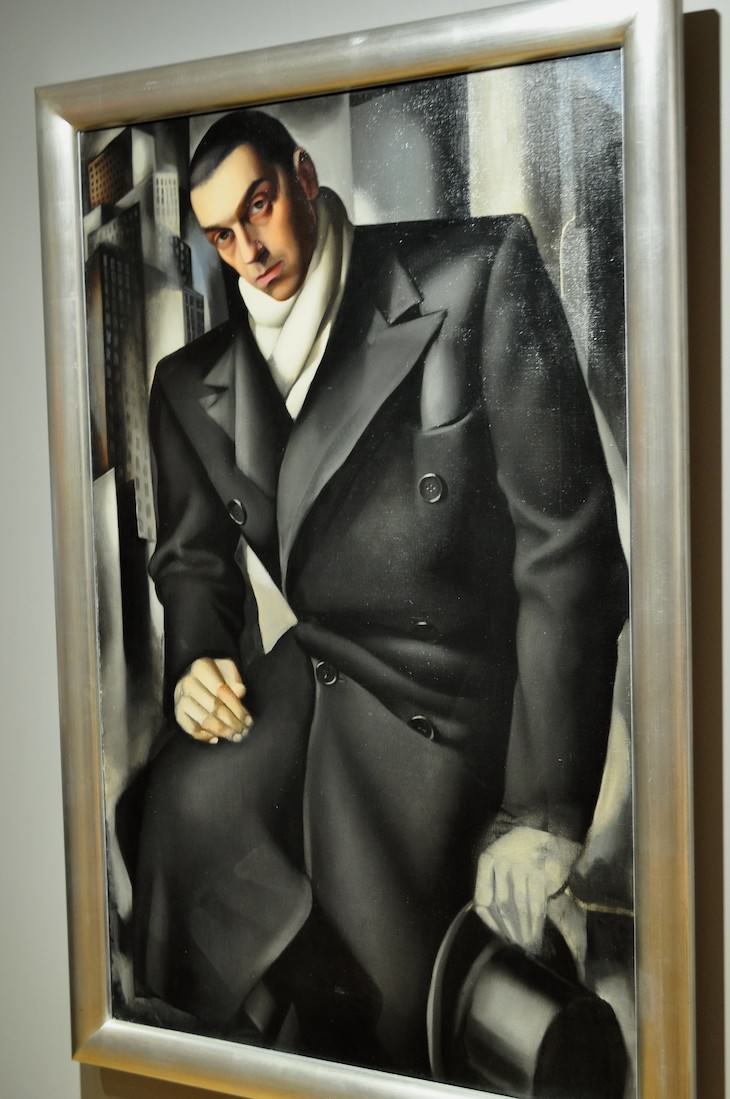 Portrait of Tadeusz Lempicka, 1928, oil on canvas, Image Source: Flickr
Portrait of Tadeusz Lempicka, 1928, oil on canvas, Image Source: FlickrShe began winning awards for her art and received constant commissions from the French elite. She eventually divorced Tadeusz Lempicki and became the mistress of the baron of former Austro-Hungarian Empire Raoul Kuffner. By 1929 she painted one of her best-known works - Autoportrait, also known as Tamara in a Green Bugatti. This depiction of herself placed at the steering wheel of a luxurious Italian race car expresses the liberation some women were experiencing at the time, as well as the consumerist culture that was prevalent in the inter-war period.
Her career reached its peak in the 1930s when she hosted a successful show at the Carnegie Institute of Pittsburgh. Shortly thereafter, she was commissioned to paint portraits for King Alfonso XIII of Spain and Queen Elizabeth of Greece. In 1934 she married Baron Kuffner and together they fled to the US following the outbreak of World War II.
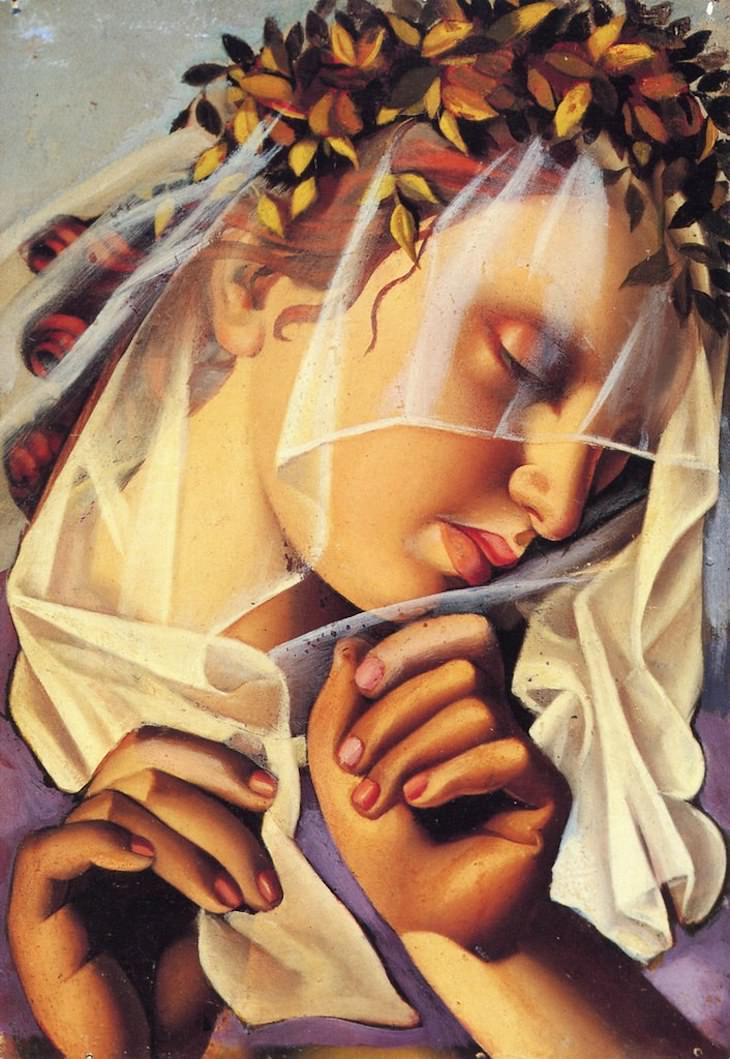 Woman with a Garland of Flowers, Image Source: Flickr
Woman with a Garland of Flowers, Image Source: FlickrDe Lempicka and her husband first settled in Beverly Hills and later relocated to New York City. She hosted numerous shows but did not attain the heights of success she hoped for. She also received far fewer commissions for society portraits as her art deco style became outdated in the period of modernism and abstract expressionism. After the death of her husband, Baron Kuffner in 1963 she officially retired from her life as a professional artist. She ultimately moved to Cuernavaca, Mexico where she died in her sleep in 1980.
While she experienced numerous periods of turmoil in her life, de Lempicka is one of the most influential and unique artists of the 20th century. Recently, in 2019, her painting Le Tunique Rose (Pink Dress) sold at a Sotheby's auction for a record $12 million.
 Portrait of Count Vettor Marcello, 1933, oil in canvas, Image Source: Wikipedia Commons
Portrait of Count Vettor Marcello, 1933, oil in canvas, Image Source: Wikipedia Commons 17:57
17:57
How Two Fake Policemen Stole $500 Million Worth of Art
In 1990, 13 works of art, valued at $500 million in total, were stolen from a museum in Boston. This is how the fake policemen conducted this mysterious heist.

12 Artworks by J.M.W. Turner That Are Worth Adoring
Take a look at some of the finest artworks by English painter J.M.W Turner that still look so unique and charming.

13 Books That Will Make Your Time Fly
These times of social distancing are perfect for catching up on your reading. Check out this list of 13 must reads to get started.

8 Movies Based on Incredible True Stories
Life has a way of outdoing fiction sometimes, and these 8 movies based on incredible true stories, prove it.

History’s 7 Most Influential Watercolor Artists
Here, we look back at some of the most famous watercolor artists throughout history whose works continue to be influential.

Have You Seen Such Great Vintage Photos Before?
Vintage photos always leave us with a sense of great nostalgia, and the 25 you're about to see are no exception. Here are 25 of them from times gone by.
 3:43
3:43
This Emotional Duet Gave Me Goosebumps of Pleasure
These two world-famous artists are amazingly talented singing alone, let alone when they join to give an emotional duet like this.

The Fascinating History of the Color RED
Red is the first color humans learned to utilize in art and a color that has a deep symbolic meaning across all cultures. Learn about the history of red in art.
 4:37
4:37
Listen to This Gorgeous Spring Piece by André Rieu
Let Master violinist André Rieu bring you a beautiful moment of relaxation in spring time...

11 Picasso Paintings That Shocked the Art Establishment
If there is one artist of the 20th century that everyone knows, it's Picasso. Here are the 11 works of his that shocked the world and cemented his fame forever.
 4:34
4:34
This Was One of Elvis Presley's Last Great Performances
Here's an extremely rare and great quality video of the King, Elvis Presley introducing and performing "Unchained Melody".
 6:28
6:28
Unbelievable Talent: 5 Unforgettable Dance Performances
Although these dance performances are from different genres, they all have one thing in common: the wow factor. These talented dancers will leave you in awe...

This Food Artist Works Some Halloween Magic Into Her Pies
Jessica Clark Bojin is a baker that makes her pies with an artistic twist, perfectly displayed in these Halloween themed spooky pies!
 9:36
9:36
This Tribal Dance Performance Will Blow Your Socks Off!
This beautiful performance of dance, poetry, and violin pieces perfectly illustrates the turbulent relationship that humans share with the natural world.

This Video Collection Will Turn You Into an Artist!
If you've ever wanted to learn how to draw but had no clue how to start, all that's about to change thanks to this video guide. Watch the videos and draw away!
 4:43
4:43
If You Like Illusions - Prepare to Be Amazed!
Amazing Dutch illusionist Hans Klok will perform 10 illusions in 5 minutes!

15 of the Most Beautiful Buildings in Art Nouveau Style
Art Nouveau architecture includes some of the most beautiful buildings that ever existed! Here, you will see 15 beautiful Art Nouveau buildings across the world.
 6:00
6:00
WATCH: This Dance Is an Ode to Beautiful Mother Nature
This shadow dance, a tribute to nature, will move you to tears through its poignancy and thanks to its stark depiction of the reality that Mother Nature faces.

Wow! this Man Can Turn a Boring Wall into Stunning Art!
Goga Tandashvili, a Russian artist, is a master of the art known as Bas-relief. Take a look at his stunning work here!
 4:29
4:29
When Classic Meets Rock: A Gorgeous Rendition
Watch and listen as the Piano Guys, famous for their renditions of modern music, play an amazing rendition of "Sweet Child o' Mine)
 4:44
4:44
This Is Arguably the Most Beautiful Ice Show Ever!
18 Russian ice skaters sealed their place in history with this amazing dance set to Whitney Houston's classic love song.
 5:51
5:51
WATCH: This Couple Was Meant to Dance Together
These dancers were meant to perform together, and I'd be happy to watch them many times over. I think you'll agree.

15 Detailed Sketches That Perfectly Capture Winter’s Charm
Every detail of winter comes alive in these pencil sketches by Guram Dolenjashvili.
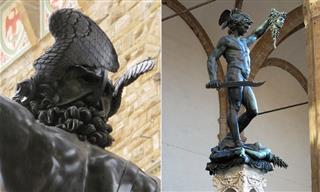
Did You Know These Famous Artworks Have HIDDEN Messages?
The 7 famous paintings and sculptures we showcase in this article have secret messages waiting to be uncovered!
 2:55
2:55
James Earl Jones: The Booming Voice We All Loved
A tribute to the booming voice of James Earl Jones, now departed.
 3:20
3:20
This Quartet Plays Carmen in a New, Wonderful Way
In the video below, they perform the famous aria from the opera "Carmen" by Georges Bizet with graceful refinement.
 4:11
4:11
Watch This Young Singer Completely Nail 'O Sole Mio'
Watch the young and incredibly talented Amira Willighagen performing the classic song, 'O Sole Mio' alongside the legendary Patrizio Buanne.
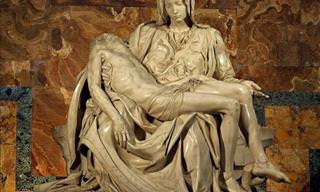
Only Michelangelo Can Turn Marble into a Masterpiece
There's no task quite as painstaking as sculpting an image that can come to life. These are some statues created by the genius Michelangelo
 5:03
5:03
Listen to an Gorgeous Version of a Beloved Canon
This is one of the most beautiful versions we've heard of Pachelbel's canon, and we're sure you'll agree with us.
 2:29
2:29
This Choir's Rendition of Ave Maria Melted My Heart
Talent shows are not all about finding the next Britney and Whitney, they also showcase some amazing, music. Here, a girl's choir perform a heavenly Ave Maria.
 3:58
3:58
A Performance of a Lifetime: The Dragon-Lion Dance!
This videos shows the traditional Chinese dance called the Lion and Dragon dance and it is performed during the spring festival.

These Gorgeous Paintings are Doors to Famous Streets...
These beautiful cityscape paintings by Alexey Butyrsky perfectly capture the streets of Paris, Venice and San Francisco.

You May Need to Give These Pictures a Second Look...
Robert Gonsalves specilizes in making the kind of paintings that make you sigh, then amazed, then thoughtful.
 11:10
11:10
This Impossible Acrobatic Performance Will Blow Your Mind
In this must-watch performance, a team of acrobats carry out feats that are seemingly impossible with ease.
 2:47
2:47
Enjoy the Genius of André Rieu!
This is a performance full of joy, laughter and the utmost love of pure musical fun.

This Artist Creates Paper Art That is Truly Breathtaking
Russian artist Yulia Broadskaya is an expert at quilling. Her work has been commissioned by a number of big brands. Here's a sample of some of her amazing work.

Music Box: Enjoy 24 of ABBA's Classic Pop Hits
ABBA's distinctive brand of pop music is still as popular today as ever. In this collection, we have selected 24 of their best hits for you to enjoy.
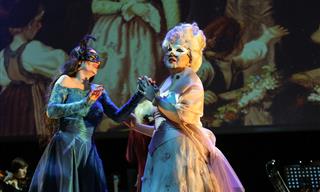
Playlist: 7 Full Length Operas With English Subtitles!
Whether you're a seasoned opera lover or a newcomer, this playlist of 7 full operas will take you on a journey through the art form's most iconic works.

These Famous Artworks Were Once Considered SCANDALOUS
Throughout history, artists have repeatedly tried to challenge societal norms. And sometimes, they succeeded. Here are 7 of history's most controversial artworks.
 3:59
3:59
This Mongolian Folk Music Sends Shivers Down My Spine
I had never even heard the Mongol language before, much less its traditional throat singing. I have to say the experience is spellbinding.
 3:10
3:10
This Beautiful Cover of Cher's 'Believe' Melted My Heart...
Watch Ella Henderson perform Cher's believe in the most impeccable way possible.
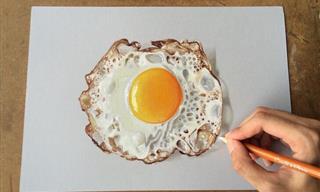
These Realistic 3D Artworks Will Make You Do a Double Take
These unbelievably realistic 3-D sketches will blow your mind.
 4:53
4:53
Over the Rainbow, There's a Musical Show With André Rieu
Andre Rieu, with Suzan Erens and His Johann Strauss Orchestra, performs 'Somewhere Over The Rainbow' from The Wizard of Oz.
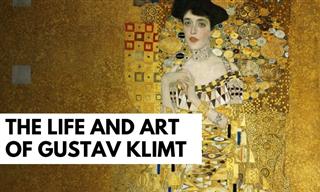
15 Beautiful Works of Art by Gustav Klimt
Gustav Klimt is one of the most celebrated artists of the 20th century. Join us on a journey through the artist’s life and admire 15 of his masterpieces.
 6:09
6:09
Watch This Pianist Explain Musical History, Musically!
If you want to know more about the development of classical music through the centuries, this brief video is just the ticket.
 7:26
7:26
Yet Another Charming Performance by the Great André Rieu
Watch yet another incredible performance by André Rieu!
 4:34
4:34
This Was One of Elvis Presley's Last Great Performances
Here's an extremely rare and great quality video of the King, Elvis Presley introducing and performing "Unchained Melody".
 6:28
6:28
Unbelievable Talent: 5 Unforgettable Dance Performances
Although these dance performances are from different genres, they all have one thing in common: the wow factor. These talented dancers will leave you in awe...

This Food Artist Works Some Halloween Magic Into Her Pies
Jessica Clark Bojin is a baker that makes her pies with an artistic twist, perfectly displayed in these Halloween themed spooky pies!
 9:36
9:36
This Tribal Dance Performance Will Blow Your Socks Off!
This beautiful performance of dance, poetry, and violin pieces perfectly illustrates the turbulent relationship that humans share with the natural world.

This Video Collection Will Turn You Into an Artist!
If you've ever wanted to learn how to draw but had no clue how to start, all that's about to change thanks to this video guide. Watch the videos and draw away!
 4:43
4:43
If You Like Illusions - Prepare to Be Amazed!
Amazing Dutch illusionist Hans Klok will perform 10 illusions in 5 minutes!

15 of the Most Beautiful Buildings in Art Nouveau Style
Art Nouveau architecture includes some of the most beautiful buildings that ever existed! Here, you will see 15 beautiful Art Nouveau buildings across the world.
 6:00
6:00
WATCH: This Dance Is an Ode to Beautiful Mother Nature
This shadow dance, a tribute to nature, will move you to tears through its poignancy and thanks to its stark depiction of the reality that Mother Nature faces.

Wow! this Man Can Turn a Boring Wall into Stunning Art!
Goga Tandashvili, a Russian artist, is a master of the art known as Bas-relief. Take a look at his stunning work here!
 4:29
4:29
When Classic Meets Rock: A Gorgeous Rendition
Watch and listen as the Piano Guys, famous for their renditions of modern music, play an amazing rendition of "Sweet Child o' Mine)
 4:44
4:44
This Is Arguably the Most Beautiful Ice Show Ever!
18 Russian ice skaters sealed their place in history with this amazing dance set to Whitney Houston's classic love song.
 4:58
4:58
This Famous Song Sounds Even Better in Acapella!
In this video the popular acapella group Pentatonix give an outstanding performance of John Lennon's famous song "Imagine".
 3:47
3:47
Is This What Falling in Love Sounds Like on Piano?
When celebrated young pianist Jarrod Radnich performed this majestic piece at such a glorious castle I could not help but be swept away.
 3:17
3:17
Incredible Art - These Are NOT Pencil Drawings!
Alfred Cheng's artworks are not made with pencil or charcoal, as it appears at first glance. He creates intricate portraits using only nails and a single thread.
To enable your Ad-Free Subscription, please fill the fields below
Your subscription was successful, now you can enjoy an ad-free experience!!
Note: To make sure you get no ads, please make sure to log in to your account. If you are logged in already, then refresh the page. The subscription can be cancelled at any time.



